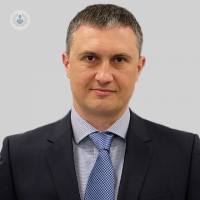Expert advice on selecting a regenerative medicine specialist
Autore:Regenerative medicine offers a modern, evidence-based approach to treating some degenerative conditions and musculoskeletal injuries. When performed safely by a trained specialist, regenerative therapies can lessen pain and improve a patient’s function and ability to perform daily tasks. Unfortunately, poor quality treatment can lead to disappointing outcomes and also puts patients at risk of complications. Renowned consultant in anaesthesia and pain medicine Dr Martynas Juozaitis gives expert guidance on ensuring your regenerative medicine practitioner is providing safe and effective treatment in this informative article.

What is regenerative medicine?
Regenerative medicine is practised by qualified and professional clinicians and doctors. Compared to other more general disciplines within medicine, which have been practiced for many hundreds of years, regenerative medicine is still seen as fairly novel. The regenerative medicine which we practice in our clinic was established around twenty years ago. Therefore, although this area of medicine is relatively new, we do have around twenty years of development, research, studies, data and outcomes in the field which prove that it is effective and safe.
Regenerative medicine helps patients to heal using their own body’s regenerative cells. As with all areas of medicine, our knowledge is constantly evolving and therefore, audits and research are continually performed in order to inform and update our practice according to the latest evidence. There are a lot of clinics which work in this area of medicine, as well as a number of ongoing research projects in universities in the UK, the United States and Europe as well as in many other parts of the world.
What are the latest advancements in regenerative medicine?
To discuss the main advancements, we have to separate current, ongoing research, which is looking into what is clinically safe and effective, from previous research which has been established and put into practice. To allow patients access to regenerative medicine within the UK, we have to decide whether we want to conduct our own research or whether we opt to use pre-existing research with its established database to inform our practice. Using previously conducted research means that UK clinicians are able to simply transfer and apply this knowledge in order to treat patients.
A simple way to explain the idea of using another body’s research is to consider the concept of franchising of McDonald's fast food chains. At a certain point in the company’s history, someone developed a specific set of techniques and processes which allowed very fast production and delivery of food at reasonable prices. When we started to work in the field of regenerative medicine, there was a lengthy period of establishing and understanding the fundamental principles. Through research and using articles written by other experts and attending conferences, we were able to find the most advanced body of clinicians at that moment in time, Regenexx®. To date, I believe that they continue to be leaders in the field of regenerative medicine due to their well-established process and longstanding register of excellent outcomes for patients, as well as their own specialist laboratory in Colorado, USA.
Advancements in regenerative medicine are ongoing and it is important that our practice is constantly reviewed and updated based on the latest data. The main benefit of working within the Regenexx® network is that together, we have treated around eighty thousand patients over twenty years, giving us a huge database and source of patient responses on which to base our practice. This knowledge is shared and all of our therapies are researched in Regenexx® laboratory and Regenexx® clinics before being released to the network. In addition, our practice is based on five years of registered data with long term outcomes; I'm not aware any other clinic or any other network which can provide such a quantity of data. Our emphasis is on providing safe and clinically proven regenerative medicine therapies with clinicians who are specially trained to help our patients have greater function and less pain.
What are the aims and applications of regenerative medicine?
In the past, to treat patients with an injury in the musculoskeletal system or a degenerative condition, we had two choices; performing surgery to add something inside the body or to take something out. Both options have the same aim of helping the patient to move better, have less pain and to be able to perform daily activities. Additional to surgery, conservative treatments such as physiotherapy or simply symptom-management or coping strategies such as pain medication were all that was available.
Regenerative medicine bridges the gap between surgery and conservative treatments. When conservative medicine, such as physiotherapy, is not sufficient but surgery is not necessary or possible, regenerative medicine helps patients to heal from injuries or degenerative conditions. Regenerative medicine works to heal the body using special therapies using the body’s own regenerative cells. This may be done using platelets, bone marrow, mesenchymal stem cells or Alpha 2 macroglobulin amongst many other types of cells. There are a variety of different techniques which employ these cells to help them to perform their full function, allowing your body to heal.
Why is it important to seek out certified and trained regenerative medicine specialists?
In terms of patient safety, there are several aspects of regenerative therapy treatment which need to be highlighted. Firstly, regenerative therapies will only be effective if they are performed safely and correctly. Therefore, it is essential that the practising clinician has had specific training and has the necessary knowledge in order to treat their patients with precision and accuracy. Information about how many patients the clinician has treated, how and for how long the outcomes are monitored and how this data is fed back into the clinician’s practice should be disclosed prior to treatment. Only in cases where the treatment process is well established and proven to be clinically safe should the patient proceed with treatment.
Another important aspect of safety in regenerative medicine is the transfer of cells, such as bone marrow or cells from the fat or the blood. They key principle in this type of treatment, particularly in musculoskeletal medicine, is that these regenerative cells are taken from the patient’s own tissue so they can be concentrated. This is necessary as although we all have these cells in our body, sometimes the naturally occurring quantity is too low, meaning that healing cannot take place effectively. A regenerative medicine clinician should be able to take those cells from the patient and process them safely. Accuracy in timing and in the processing techniques themselves, as well as sterile conditions, are essential in order to keep the cells alive.
These cells have to then be positioned precisely within the body part where healing needs to take place, which is sometimes done using injections with very fine needles. To ensure accuracy, this process is performed using image guidance. In some cases of poor practice, blind injections are given which compromises safety and outcomes for patients and can lead to complications. Excellence and precision in regenerative medicine treatment stems from high quality and up-to-date training for clinicians. Although medical professionals are very experienced in giving injections, it is important that they receive specialist training on injecting tendons, ligaments and muscles using image guidance so that the regenerative cells can be observed. In my own training at the Regenexx® primary clinic in Colorado, USA, I underwent specialist training and examination by experts in the field.
As well as within our own network, there are a number of good regenerative medicine clinicians practising in the UK. However, to ensure they receive safe and effective treatment, I would stress that patients should be asking questions on the following:
- the quantity of procedures the clinician has performed
- the training the clinician has received
- how the therapies are applied, including injection techniques and the use of image guidance
- the evidence that their procedures are effective and safe
- where the outcome data from previous patients can be accessed
Being aware and informed of these issues helps the patient ensure they will receive good quality, effective and safe treatment. As a qualified practitioner, I hope that as the field of regenerative medicine expands that clinics will practice safe, effective, evidence based techniques. Poorly performed regenerative therapies are a safety risk and lead to disappointment for patients.
If you think you could benefit from regenerative therapies and wish to book a consultation with Dr Juozaitis, don’t hesitate to visit his Top Doctors profile.


